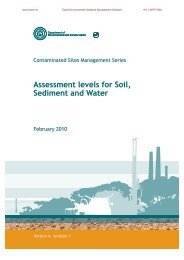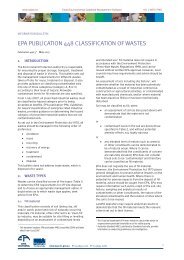Soil Generic Assessment Criteria for Human Health Risk ... - ESdat
Soil Generic Assessment Criteria for Human Health Risk ... - ESdat
Soil Generic Assessment Criteria for Human Health Risk ... - ESdat
You also want an ePaper? Increase the reach of your titles
YUMPU automatically turns print PDFs into web optimized ePapers that Google loves.
www.esdat.net Esdat Environmental Database Management Software +61 2 8875 7948<br />
Di n butyl phthalate CAS 84-74-2 Assessor A: Barry Mitcheson, Enviros Assessor B: Alison Pugh, Hyder Final review: Panel/SF<br />
Date 05/05/2009 Date 05/05/2009 Date 26/08/2009<br />
MDI Recommended MDIoral Units Justification: Large range of values <strong>for</strong> oral exposure. A mid range value (towards the upper end) which is referenced in Canada, and 2 of the recent German studies.<br />
133 ug day-1 Exposure may be greater <strong>for</strong> infants due to infant milk, but will be <strong>for</strong> a relatively shor<br />
Organisation Date Media Value Units Description Reference Web link<br />
Food Standards Agency 1993 Diet 31 ug day-1 Mean 0.013mg/person/day High end 0.031mg/person per day) 82: MAFF UK - Phthalates in Food (March 1996) Table 2: Estimated mean and high<br />
level (97.5th percentile) intakes of individual phthalates from carcass meat, poultry,<br />
eggs and milk, based on the analysis of 1993 Total Diet Study samples<br />
Committee on Toxicity of<br />
Chemicals in Food, Consumer<br />
Products and the Environment<br />
(COT)<br />
1998 Infant milk 13.44 ug day-1 At birth 2.4ug/kgbw/day to 1.4ug/kgbw/day at six months, converts using 5.6kg<br />
bodyweight fo 0-1 year old<br />
Food Surveillance sheet Number 168 December 1998 MAFF UK - PHTHALATES IN<br />
INFANT FORMULAE - FOLLOW-UP SURVEY Table 2: Concentrations and Estimated<br />
Average.<br />
http://archive.food.gov.uk/maff/archive/food/infsheet/1998/no168/tables.htm<br />
Exposure to Individual and Total Phthalates of Infants at Birth and Six Months of Age<br />
from Retail Infant Formulae<br />
12/04/2009 No Data TOX/2004/25 COMMITTEE ON TOXICITY OF CHEMICALS IN FOOD,<br />
CONSUMERPRODUCTS AND THE ENVIRONMENT- TOXICOLOGICAL EVALUATION OF<br />
A PILOT STUDY FOR A BREAST- MILK ARCHIVE<br />
European Chemicals Bureau (ECB) 12/04/2009 Food, air and water 25.13 ug day-1 3.59x10-4 mg/kgbw/day based on regional modelling using EUSES Calculation <strong>for</strong><br />
adults using 70kg body weight<br />
European Union <strong>Risk</strong> <strong>Assessment</strong> Report Volume 29 , 2003 with addendum 2004<br />
www.food.gov.uk<br />
http://archive.food.gov.uk/maff/archive/food/infsheet/1996/no82/table2.htm<br />
#Table2<br />
www.cot.food.gov.uk<br />
http://ecb.jrc.it/<br />
http://ecb.jrc.ec.europa.eu/DOCUMENTS/Existing-<br />
Chemicals/RISK_ASSESSMENT/REPORT/dibutylphthalatereport003.pdf<br />
European Food Safety Authority<br />
(EFSA)<br />
12/04/2009 Food, air and water 2.872 ug day-1 3.59x10-4 mg/kgbw/day based on regional modelling using EUSES Calculation <strong>for</strong><br />
children ujsing 8kg body weight<br />
12/04/2009 Diet 31 ug day-1 The limited available data on DBP concentration in foods and diets in the UK and<br />
Denmark were used to provide an estimation of dietary exposure. In the UK, mean<br />
and high (97.5th percentile) intakes of DBP from dietary sources were estimated to<br />
be respectively 0.013 and 0.031 mg/person/day in the adult population (equivalent<br />
<br />
12/04/2009 Diet 29 <strong>for</strong> adults,in first study and<br />
in second study 112 <strong>for</strong><br />
adults, 64 <strong>for</strong> 1-6 children<br />
and 3.5 * bodyweight of a 7-<br />
14 year old child<br />
ug day-1<br />
European Union <strong>Risk</strong> <strong>Assessment</strong> Report Volume 29 , 2003 with addendum 2004<br />
The EFSA Journal (2005) 242, 1-17<br />
Opinion of the Scientific Panel on Food Additives,<br />
Flavourings, Processing Aids and Material in Contact with Food (AFC)<br />
on a request from the Commission related to<br />
Di-Butylphthalate (DBP) <strong>for</strong> use in food contact materials<br />
Question N° EFSA-Q-2003-192<br />
Adopted on 23 June 2005 by written procedure<br />
A Danish study estimated mean DBP exposure between 0.13 to 0.29 mg/day, i.e. The EFSA Journal (2005) 242, 1-17<br />
Opinion of the Scientific Panel on Food Additives,<br />
concentrations, exposure at high percentiles estimated as 0.72 mg/day equivalent Flavourings, Processing Aids and Material in Contact with Food (AFC)<br />
on a request from the Commission related to<br />
root crops (83%) and leaf crops (13%). The oral daily intake <strong>for</strong> Denmark was Di-Butylphthalate (DBP) <strong>for</strong> use in food contact materials<br />
Question N° EFSA-Q-2003-192<br />
<br />
Adopted on 23 June 2005 by written procedure<br />
http://ecb.jrc.ec.europa.eu/DOCUMENTS/Existing-<br />
Chemicals/RISK_ASSESSMENT/REPORT/dibutylphthalatereport003.pdf<br />
www.efsa.europa.eu/en.htm<br />
http://www.efsa.europa.eu/cs/BlobServer/Scientific_Opinion/afc_op_ej242_d<br />
bp_en2.pdfssbinary=true<br />
http://www.efsa.europa.eu/cs/BlobServer/Scientific_Opinion/afc_op_ej242_d<br />
bp_en2.pdfssbinary=true<br />
European Centre <strong>for</strong><br />
Ecotoixcology and Toxicology of<br />
Chemicals (ECETOC)<br />
12/04/2009 Infant milk <strong>for</strong>mula and<br />
breast milk<br />
91.84 <strong>for</strong>








